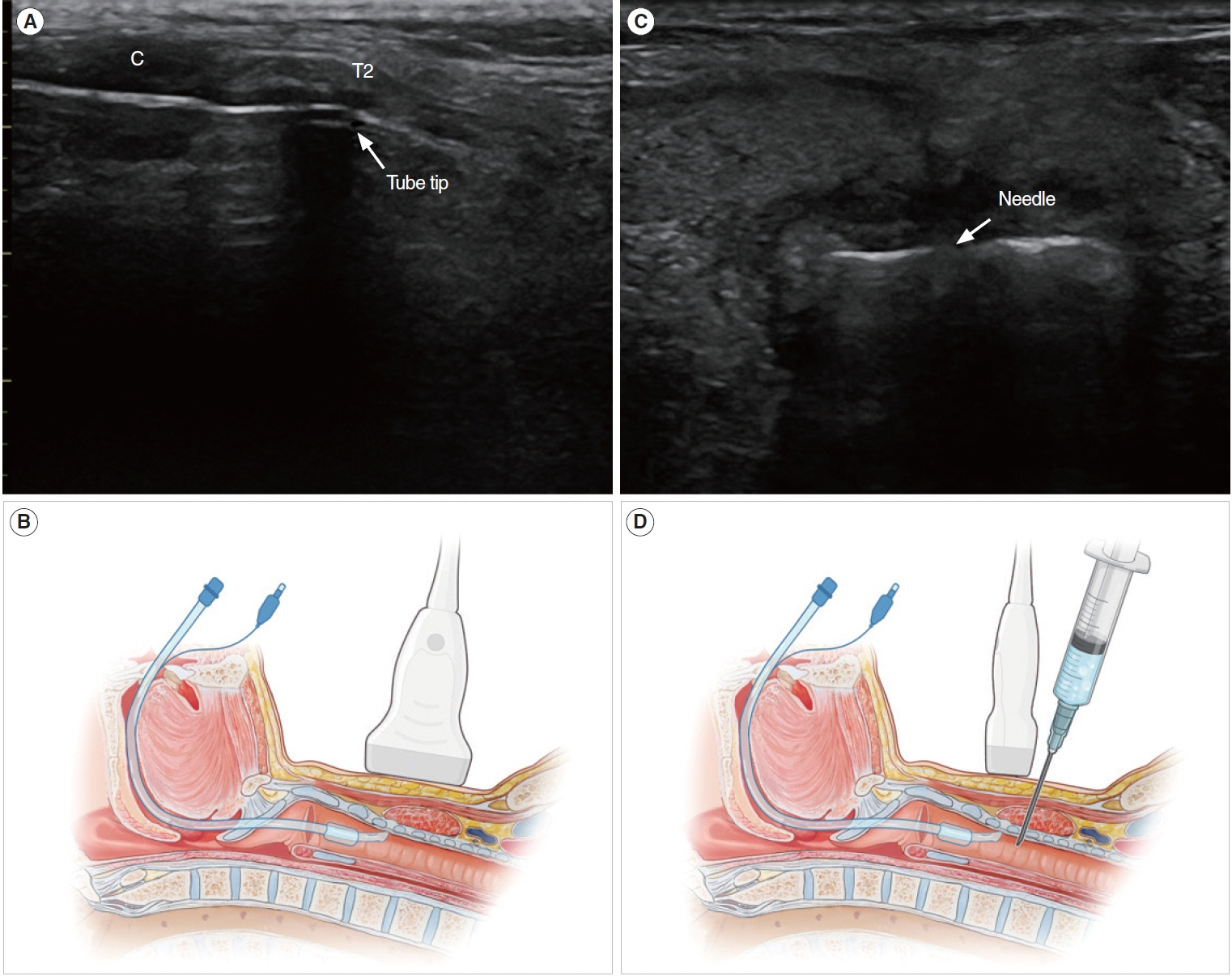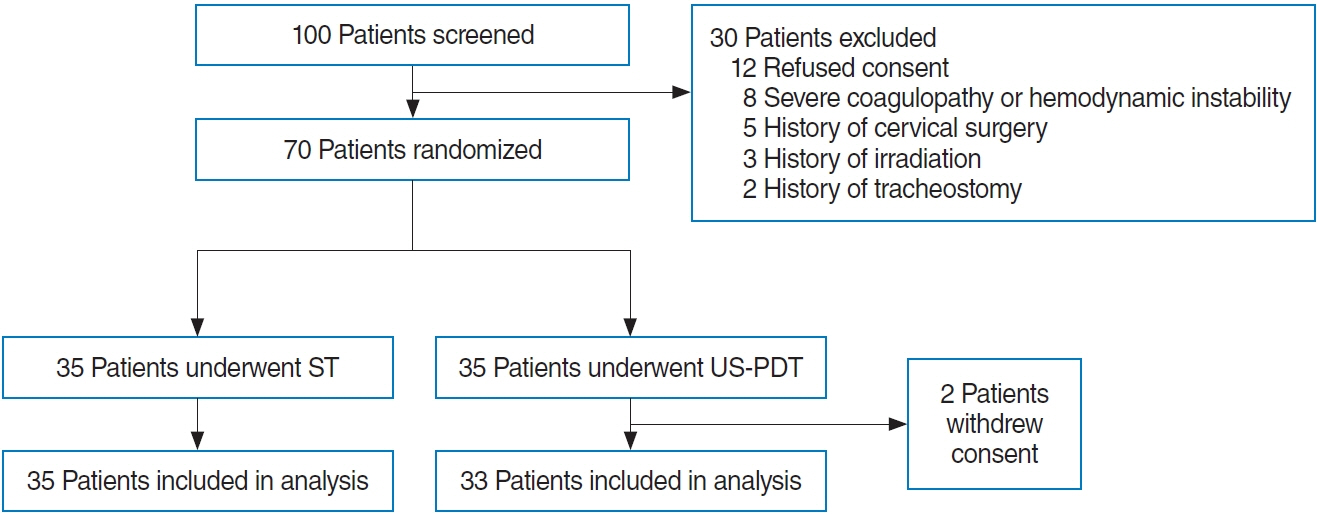Clin Exp Otorhinolaryngol.
2023 Nov;16(4):388-394. 10.21053/ceo.2023.01088.
Comparison between Real-Time Ultrasound-guided Percutaneous Dilatational Tracheostomy and Surgical Tracheostomy in critically ill Patients: A Randomized Controlled Trial
- Affiliations
-
- 1Department of Otorhinolaryngology-Head and Neck Surgery, Soonchunhyang University Bucheon Hospital, Soonchunhyang University College of Medicine, Bucheon, Korea
- 2Department of Internal Medicine, Soonchunhyang University Bucheon Hospital, Soonchunhyang University College of Medicine, Bucheon, Korea
- KMID: 2548367
- DOI: http://doi.org/10.21053/ceo.2023.01088
Abstract
Objectives
Tracheostomy is an important procedure for critically ill patients in the intensive care unit (ICU), and percutaneous dilatational tracheostomy (PDT) has gained popularity due to its safety and effectiveness. However, there are limited data comparing ultrasound-guided PDT (US-PDT) with surgical tracheostomy (ST). In our previous study, we reported that US-PDT had similar safety and effectiveness to ST, with a shorter procedure time. However, the study design was retrospective, and the sample size was small. Therefore, we conducted a randomized controlled trial to demonstrate the safety and efficacy of US-PDT compared to ST.
Methods
A total of 70 patients who underwent either US-PDT (n=35) or ST (n=35) were enrolled in the study between October 20, 2020, and July 26, 2022. The patients were randomly assigned to their respective procedures. The data collected included patient clinical characteristics, procedure time and details, complications, duration of ICU stay, time taken for weaning from mechanical ventilation, and hospital mortality.
Results
The procedure time of US-PDT was shorter than that of ST (4.0±2.2 minutes vs. 10.1±4.6 minutes). The incision length of US-PDT was also shorter than that of ST (1.5±0.5 cm vs. 1.8±0.4 cm). There were no statistically significant differences in demographics, procedure details, complications, length of ICU stay, ventilator weaning time, and hospital mortality.
Conclusion
US-PDT has a similar complication rate and shorter procedure time compared with ST. It can be safely and effectively performed in critically ill patients and can serve as a potential alternative to ST.
Figure
Reference
-
1. Cox CE, Carson SS, Holmes GM, Howard A, Carey TS. Increase in tracheostomy for prolonged mechanical ventilation in North Carolina, 1993-2002. Crit Care Med. 2004; Nov. 32(11):2219–26.2. Toursarkissian B, Zweng TN, Kearney PA, Pofahl WE, Johnson SB, Barker DE. Percutaneous dilational tracheostomy: report of 141 cases. Ann Thorac Surg. 1994; Apr. 57(4):862–7.3. Higgins KM, Punthakee X. Meta-analysis comparison of open versus percutaneous tracheostomy. Laryngoscope. 2007; Mar. 117(3):447–54.4. Freeman BD, Isabella K, Lin N, Buchman TG. A meta-analysis of prospective trials comparing percutaneous and surgical tracheostomy in critically ill patients. Chest. 2000; Nov. 118(5):1412–8.5. Ciaglia P, Firsching R, Syniec C. Elective percutaneous dilatational tracheostomy. A new simple bedside procedure: preliminary report. Chest. 1985; Jun. 87(6):715–9.6. Crofts SL, Alzeer A, McGuire GP, Wong DT, Charles D. A comparison of percutaneous and operative tracheostomies in intensive care patients. Can J Anaesth. 1995; Sep. 42(9):775–9.7. Shin HI, Jang KI, Kim KM, Nam IC. Comparison of surgical tracheostomy and percutaneous dilatational tracheostomy in intensive care unit patients. Korean J Otorhinolaryngol-Head Neck Surg. 2019; May. 62(5):288–93.8. Cho YJ. Percutaneous dilatational tracheostomy. Tuberc Respir Dis (Seoul). 2012; Mar. 72(3):261–74.9. Gobatto AL, Besen BA, Tierno PF, Mendes PV, Cadamuro F, Joelsons D, et al. Ultrasound-guided percutaneous dilational tracheostomy versus bronchoscopy-guided percutaneous dilational tracheostomy in critically ill patients (TRACHUS): a randomized noninferiority controlled trial. Intensive Care Med. 2016; Mar. 42(3):342–51.10. Saritas A, Kurnaz MM. Comparison of bronchoscopy-guided and real-time ultrasound-guided percutaneous dilatational tracheostomy: safety, complications, and effectiveness in critically ill patients. J Intensive Care Med. 2019; Mar. 34(3):191–6.11. Gobatto AL, Besen BA, Tierno PF, Mendes PV, Cadamuro F, Joelsons D, et al. Comparison between ultrasound- and bronchoscopy-guided percutaneous dilational tracheostomy in critically ill patients: a retrospective cohort study. J Crit Care. 2015; Feb. 30(1):220.12. Ravi PR, Vijay MN. Real time ultrasound-guided percutaneous tracheostomy: is it a better option than bronchoscopic guided percutaneous tracheostomy. Med J Armed Forces India. 2015; Apr. 71(2):158–64.13. Heikkinen M, Aarnio P, Hannukainen J. Percutaneous dilational tracheostomy or conventional surgical tracheostomy. Crit Care Med. 2000; May. 28(5):1399–402.14. Kang HT, Kim SY, Lee MK, Lee SW, Baek A, Park KN. Comparison between real-time ultrasound-guided percutaneous tracheostomy and surgical tracheostomy in critically ill patients. Crit Care Res Pract. 2022; Sep. 2022:1388225.15. Sustic A, Zupan Z, Eskinja N, Dirlic A, Bajek G. Ultrasonographically guided percutaneous dilatational tracheostomy after anterior cervical spine fixation. Acta Anaesthesiol Scand. 1999; Nov. 43(10):1078–80.16. Kupeli I, Nalbant RA. Comparison of 3 techniques in percutaneous tracheostomy: traditional landmark technique; ultrasonography-guided long-axis approach; and short-axis approach: randomised controlled study. Anaesth Crit Care Pain Med. 2018; Dec. 37(6):533–8.17. Iftikhar IH, Teng S, Schimmel M, Duran C, Sardi A, Islam S. A network comparative meta-analysis of percutaneous dilatational tracheostomies using anatomic landmarks, bronchoscopic, and ultrasound guidance versus open surgical tracheostomy. Lung. 2019; Jun. 197(3):267–75.18. Boran OF, Bilal B, Bilal N, Oksuz H, Boran M, Yazar FM. Comparison of the efficacy of surgical tracheostomy and percutaneous dilatational tracheostomy with flexible lightwand and ultrasonography in geriatric intensive care patients. Geriatr Gerontol Int. 2020; Mar. 20(3):201–5.19. Rajajee V, Fletcher JJ, Rochlen LR, Jacobs TL. Real-time ultrasoundguided percutaneous dilatational tracheostomy: a feasibility study. Crit Care. 2011; 15(1):R67.20. Sustic A, Kovac D, Zgaljardic Z, Zupan Z, Krstulovic B. Ultrasoundguided percutaneous dilatational tracheostomy: a safe method to avoid cranial misplacement of the tracheostomy tube. Intensive Care Med. 2000; Sep. 26(9):1379–81.21. Petiot S, Guinot PG, Diouf M, Zogheib E, Dupont H. Learning curve for real-time ultrasound-guided percutaneous tracheostomy. Anaesth Crit Care Pain Med. 2017; Oct. 36(5):279–83.22. Sustic A, Krstulovic B, Eskinja N, Zelic M, Ledic D, Turina D. Surgical tracheostomy versus percutaneous dilational tracheostomy in patients withanterior cervical spine fixation: preliminary report. Spine (Phila Pa 1976). 2002; Sep. 27(17):1942–5.23. Cramer JD, Graboyes EM, Brenner MJ. Mortality associated with tracheostomy complications in the United States: 2007-2016. Laryngoscope. 2019; Mar. 129(3):619–26.24. Yaremchuk K. Regular tracheostomy tube changes to prevent formation of granulation tissue. Laryngoscope. 2003; Jan. 113(1):1–10.25. Ravi PR, Vijai MN, Shouche S. Realtime ultrasound guided percutaneous tracheostomy in emergency setting: the glass ceiling has been broken. Disaster Mil Med. 2017; Nov. 3:7.26. Berges AJ, Lina IA, Ospino R, Tsai HW, Brenner MJ, Pandian V, et al. Quantifying viral particle aerosolization risk during tracheostomy surgery and tracheostomy care. JAMA Otolaryngol Head Neck Surg. 2021; Sep. 147(9):797–803.
- Full Text Links
- Actions
-
Cited
- CITED
-
- Close
- Share
- Similar articles
-
- Percutaneous Dilatational Tracheostomy
- Ultrasound-Guided Percutaneous Dilatational Tracheostomy for Critically Ill Patients With COVID-19
- Comparison of Conventional Surgical Tracheostomy and Percutaneous Dilatational Tracheostomy in the Neurosurgical Intensive Care Unit
- Safety and Feasibility of Percutaneous Dilatational Tracheostomy Performed by a Neurointensivist Compared with Conventional Surgical Tracheostomy in Neurosurgery Intensive Care Unit
- Assessing Clinical Feasibility and Safety of Percutaneous Dilatational Tracheostomy During Extracorporeal Membrane Oxygenation Support in the Intensive Care Unit



